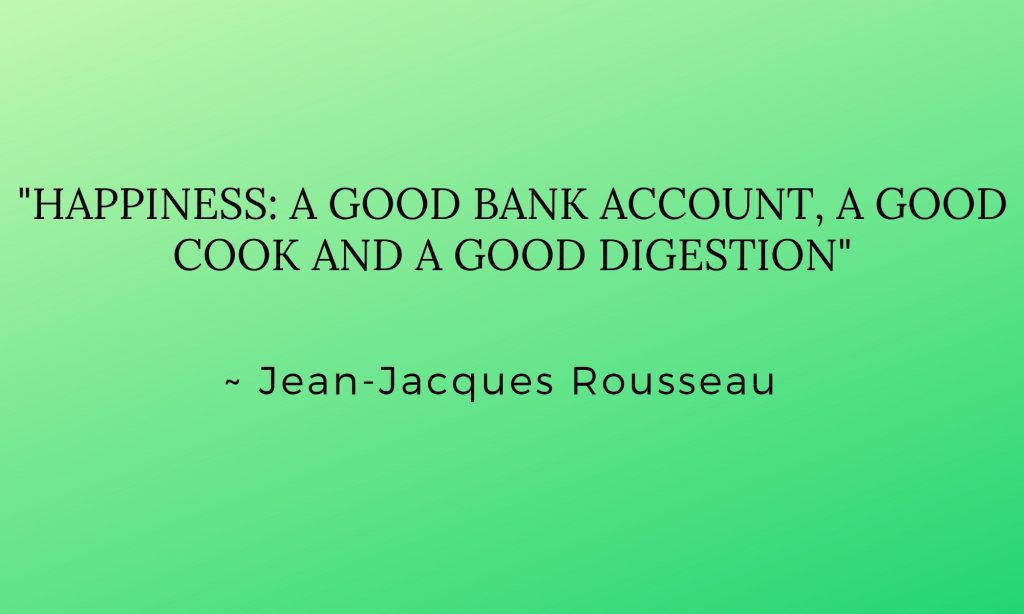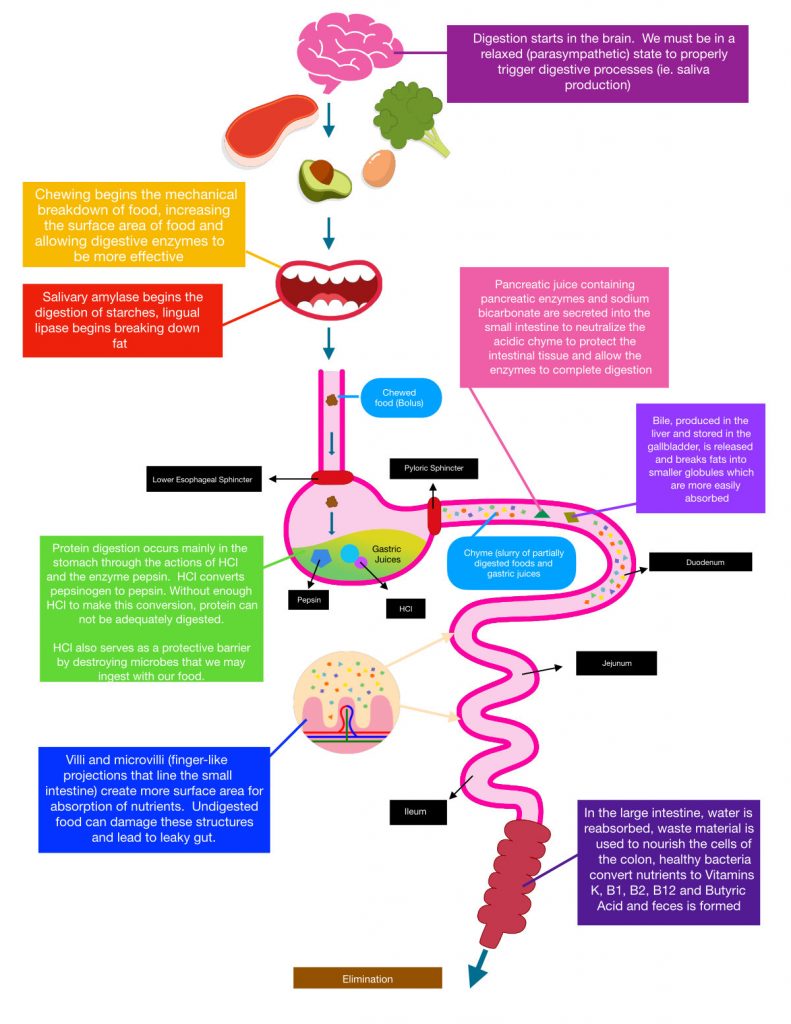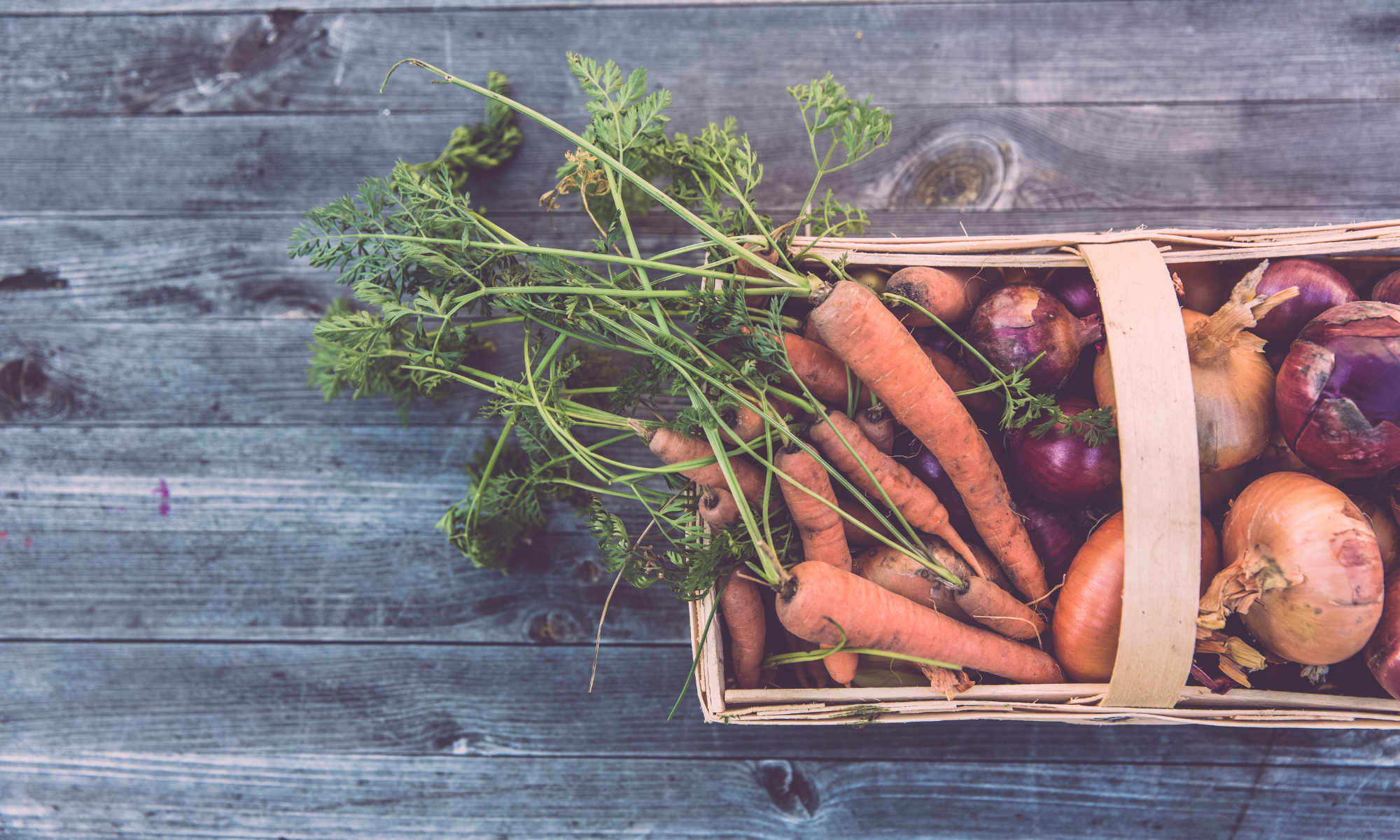
I can probably help you out with two of those ingredients for happiness….you’re on your own with the bank account! Digestion. Ingesting, breaking down, absorbing and eliminating food stuffs. Seems pretty simple but, in reality, good digestion is a pretty complex process with lots of moving parts. Kind of like a well-conducted orchestra, the processes of digestion cue each other and work together melodiously. For a lot of us, our digestive orchestra is pretty out of tune causing symptoms like indigestion, bloating and well…a really loud horn section (if you get my drift)!
Before we dig into everything that can go wrong in our guts, let’s take a look at what GOOD digestion looks like. Fair warning, if you don’t geek out on physiology like I do, this might be a little intense. But bear with me! It will make understanding what’s wrong with your digestion a lot clearer. My proofreader (husband) said he “learned a lot, but it reads a bit like a textbook”. Ugh. I tried to make it as conversational as possible. Since I may have missed the mark, there is a “Cliff Notes” diagram at the end of the post for anyone who wants it! Oh, and he also informs me that one no longer needs to insert two spaces after a period!?! I’m living in the dark ages of typewriters and word processors I guess. I’ll work on improving my tech savvy – promise!
If I were to ask you where digestion starts, what would you say? I conducted a highly sophisticated study ( ok, I asked three people – very smart people though) and 100 percent of them answered incorrectly. Folks, digestion begins in the BRAIN!!! Are your “digestive starting points” blown?!? Yep, digestion is a north to south process starting in your noggin. The sight, smell or even thought of food triggers our brain to stimulate the salivary glands to produce saliva and stimulates the gastric glands to start releasing gastric juices. This only happens when we are in a relaxed or parasympathetic state. The brain can shut down digestion completely in stressful situations. More on this when we discuss dysfunction – for now we’ll assume everything is calm, zen and the juices are flowing.
So once we are drooling over the great smells coming out of the kitchen, have decided to chow down and put a delicious forkful of food in our mouth, the actual breakdown of the food begins. Chewing provides mechanical breakdown of the food, while enzymes in the saliva begin the chemical breakdown. Salivary amylase is the primary enzyme in saliva and it begins the digestion of carbohydrates, or starches, into simple sugars. If you were to chew and chew and chew on a cracker, for example, it will eventually start to taste sweet because those amylases are breaking the starch down into simpler sugars. Along with amylases, the saliva contains lipase, which begins the digestion of fats, and lysozyme. Lysozyme doesn’t play a role in digesting our food, but does digest carbohydrates in certain bacterial cell walls and serves as protection from any little nasties we may ingest. Saliva also moistens the food, allowing for easier transfer down the tract. So once we’ve chewed and moistened our bite of food adequately, we have a bolus. The bolus is swallowed and travels through the esophagus to the stomach – the first of the BIG 3 organs of digestion.
In the stomach, the mechanical breakdown of the food continues via mixing and churning. It is here though, that the chemical breakdown really gets going. Gastric juices are composed of mucus (from mucus cells) that protects the lining of the stomach from the extremely acidic environment, pepsinogen (from chief cells) which is converted by stomach acid to the protein cleaving pepsin and hydrochloric acid (HCl) from parietal cells. HCl serves many functions. It disinfects the stomach, kills bacteria and parasites, activates pepsin for protein digestion, breaks down some proteins on its own and stimulates release of gastrin which both increases the muscle contraction of the gut and stimulates the stomach to release more gastric acid. That’s a pretty hardworking acid! Imagine all the things that could go wrong when we don’t have enough stomach acid ( totally foreshadowing here…).
Ok..so our bolus of food has been churned and mixed with gastric juices and becomes a lovely little slurry called CHYME. When the particles in the chyme are small enough and its pH is acidic enough, it passes through the pyloric sphincter and into the upper part of the small intestine called the duodenum. The small intestine is where the majority of the digestion and absorption takes place. It’s also where we’ll see the other two of our BIG 3 organs of digestion come into play. The chyme that enters the small intestine is super acidic at a pH between 1.5 and 3 (it has to be in order to “open the door” to the small intestine), so the walls of the duodenum start secreting mucus for protection. At the same time, it starts secreting two hormones into the blood stream, secretin and cholecystokinin (CCK). I know, I know. I’m throwing some big, consonant heavy words at you, but don’t worry, there isn’t a quiz. Unless you want there to be….it can be arranged! So the secretin travels through the bloodstream to the second of the BIG 3 organs, the pancreas. Here it acts as a sort of fireman, stimulating the pancreas to release a flood of bicarbonate into the duodenum via the pancreatic duct. This brings the pH of the chyme up towards neutral (pH 7) and creates an environment optimal for the work of the enzyme portion of the pancreatic juices. The release of these enzymes from the pancreas is stimulated by cholecystokinin. Although the stomach started the digestion (mostly of proteins), there is still a lot of work to be done and the juices from the pancreas contain enzymes to digest all three macronutrients – carbohydrate, fats and proteins. CCK also stimulates our last BIG 3 organ, the gallbladder. The gallbladder, under the prompting of CCK, releases bile into the small intestine. Bile aids in the absorption and digestion of fats by breaking down, or emulsifying, the fat molecules into smaller globules. This creates more surface area for the actions of the enzymes for fat digestion (lipases) and the breakdown can occur more quickly.
So now we’ve broken down our food – carbohydrates into monosaccharides, such as glucose; proteins into peptides and amino acids; fats into fatty acids and glycerol molecules – and we continue our journey south in the small intestine to the jejunum. This is where the majority of the absorption occurs. The small intestine is not flat, but consists of circular folds. Lining the surface of these folds are millions of little “finger-like” projections called villi and microvilli that point in towards the centre where our absorbable nutrients are hanging out. These folds, villi and microvilli serve to increase the surface area of the small intestine to allow more area through which these molecules can be absorbed. The total surface area of the small intestine is about 250 square meters; the size of a tennis court! Here the nutrient molecules are absorbed into the blood stream and carried throughout the body. Assuming our digestion game is on point, all that’s left at this point is some indigestible fibers, bile, water and cells that have sloughed off the lining of the gastrointestinal tract.
The final leg of the journey takes us through the ileocecal valve and into the large intestine. This is the recycling centre of the body. Here the body recycles water by reabsorption, uses some of the waste material to nourish the colon cells, converts certain nutrients into vitamins (Vitamins K, B1, B2, B12 and butyric acid) with the help of our friendly gut bacteria and, yes finally, forms and expels the remainder as feces.
Phew!! If you made it through all that, I seriously applaud you! Our digestive system – such an amazing, organized and efficient machine. At any step, however, things can get derailed….like seriously, careening off the tracks, derailed. And this is where we’ll pick up next time with a hopefully (but, not likely) MUCH shorter post! Thanks for hanging in there!
For those of you that gave up on my verbal (written?) diarrhea (sorry, bad choice of words perhaps) – here is the bare bones summary as promised waaaay back at the beginning of the post (you can click on it to open a larger image!).


